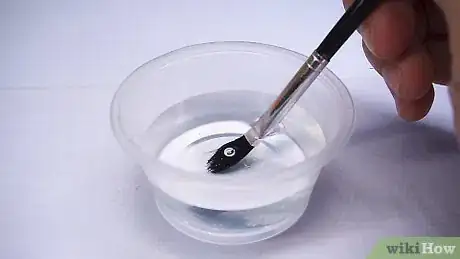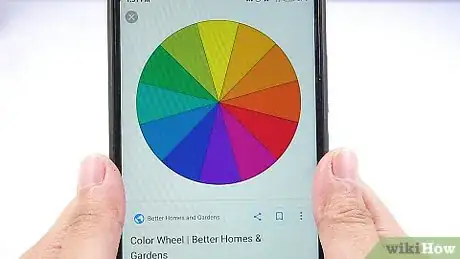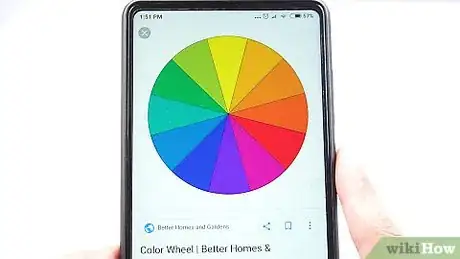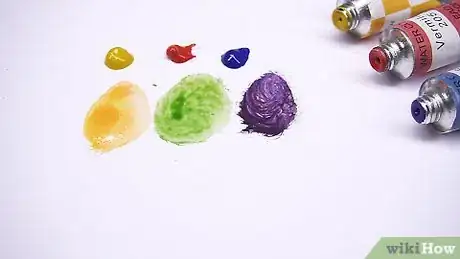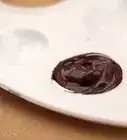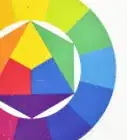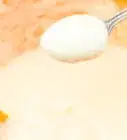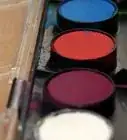This article was co-authored by Kelly Medford. Kelly Medford is an American painter based in Rome, Italy. She studied classical painting, drawing and printmaking both in the U.S. and in Italy. She works primarily en plein air on the streets of Rome, and also travels for private international collectors on commission. She founded Sketching Rome Tours in 2012 where she teaches sketchbook journaling to visitors of Rome. Kelly is a graduate of the Florence Academy of Art.
There are 9 references cited in this article, which can be found at the bottom of the page.
This article has been viewed 32,837 times.
Mixing different colors of paint together when water coloring will give you access to a variety of new hues and tones which can improve the versatility of your artwork. When water coloring, you can either mix your paint on a pallet, or you can do your mixing directly on your artwork. To achieve the specific colors that you want, you'll have to study or refer to a color wheel.
Steps
Mixing the Paint
-
1Squeeze the watercolor paints onto a pallet if you’re using tubed paint. Take off the cap from your paint and squeeze the tube so some paint pushes out of the top of the tube. Smear a small dab of paint onto your pallet and screw the cap back onto the tube. Repeat the steps for the second color that you want to mix.[1]
- If you are using a watercolor paint kit or dry watercolor paint, you can skip this step.
- Tubed watercolor paint is similar to acrylic or oil paint in appearance.
-
2Dip your brush into a cup of water. Set a cup filled with water onto the surface of your workstation so that you can clean and wet your brush. Dip the end of the brush into the water to fully saturate it.[2]
- Water will activate the paint and is necessary when painting with watercolor.
- Replace the water when it becomes murky brown or black.
Advertisement -
3Dip your brush into the first color you want to mix. Spread the tip of the brush into the paint to transfer it to your brush. You’ll notice that the paint will start to look more translucent.[3]
- The water will lighten the color of the paint.
-
4Clean off and re-wet your brush. Dip the brush into the cup of water and swirl it around the cup to clean the paint off the bristles. If you’re using tubed paint, you may want to wipe down the bristles of the brush with a rag to remove any remaining paint.[4]
- If you wipe down the bristles with a rag, dip the brush back into the water to re-wet it.
-
5Mix the second color with the first. Take the wet brush and smear it into the second color that you want to mix. Then, take the brush and swirl it into the first color on your pallet. This will mix both colors together to create a new pigment.[5]
- Make sure that you mix enough paint to fill the desired space on your canvas. Matching the hue a second time around is much more difficult.
- The color of the paint will be a lighter hue after it dries.
Painting Bold Colors
-
1Look at a color wheel to figure out different color combinations. The color wheel will list the primary, secondary, and tertiary colors. Having this information in front of you as you paint will help you determine the color you’ll achieve when mixing colors together.[6]
-
2Mix 2 primary colors together to achieve a secondary color. The 3 primary colors are red, yellow, and blue. You can mix these colors together to achieve the secondary colors of orange, violet, and green. Mixing yellow and red together creates orange, mixing blue and red creates violet, and mixing blue and yellow creates green.[7]
- Get a warm and cool variation of each primary color to expand your possible color combinations.
-
3Combine a primary color with a secondary color to get a tertiary color. Tertiary colors include blue-green, yellow-green, yellow-orange, red-orange, red-purple, and blue-purple. These colors are achieved by mixing a primary color with a secondary color and can give you access to more hues in your artwork.[8]
- Mixing too many colors together can give your painting a muddy or gray appearance.
-
4Add black to a color to make it darker. If your colors are too light, adding a dab of black paint to them will darken up the color. For instance, if you have a blue but you want to make navy blue, adding a small amount of black paint to the blue will darken it.[9]
- Adding black to light red will make it a dark red or ruby red.
-
5Spread the paint onto a pallet for more control. You can buy a paper or wood pallet from an art store or you can purchase one online. Take the loaded brush and spread it out on a pallet to pre-mix your paint. Mixing the paint prior to applying it to your canvas will make it easier to achieve the precise color that you want.[10]
- Premixing the paint on a pallet will also give you a greater uniformity of color.
-
6Let one color dry before applying the second color for a glaze. Glazing is a technique that’s used to make the top layer of paint appear translucent over a bottom layer of paint. To do this, apply your first color to your watercolor paper or canvas and let it dry. Then, take the second color and paint over the first dried layer of paint. This will create a translucent effect on your artwork.[11]
- Glazing is more effective when the first coat of paint is a darker hue than the second coat.
Creating Lighter Tones
-
1Refer to a color wheel to help you determine color combinations. The color wheel will list all of the primary, secondary, and tertiary colors. Having this information in front of you will make it easier to determine the results of two color combinations. Memorize or refer to a color wheel while you’re mixing your paint so that you know which colors you’re likely to achieve.[12]
- The color wheel will also list each colors' complementary color or the color on the opposite side of the color wheel.
-
2Mix primary colors together to get orange, green, and violet. The primary colors are red, yellow, and blue. When you mix red and yellow together, you get orange. When you mix red and blue together you get violet. Mixing yellow and blue together makes green. Keep this in mind when mixing your colors together so that you'll know which hue you’ll achieve.[13]
- Orange, green, and violet are known as secondary colors.
-
3Mix secondary and primary colors together to achieve a tertiary color. Mixing a secondary color with the primary color next to it on the color wheel will give you a tertiary color. For instance, mixing yellow and green together will give you a yellow-green hue. Mixing blue and violet together will give you a blue-violet color.[14]
- Doing this will give you access to many different colors on the color wheel.
-
4Add white to a color to lighten it. Adding a dab of white to the color that you're mixing will lighten it. For instance, the color pink is achieved by mixing white paint into red paint. If you have a dark purple but want a lighter shade of purple, adding a dab of white to it will make it lighter.[15]
- Mixing the 3 primary colors of red, blue, and yellow together will make white.
-
5Neutralize a color by mixing it with its opposite color. If you want to reduce the appearance of certain colors, you can mix in more of its opposite, or complementary color, to neutralize it. For example, if your painting is too yellow, you can mix in violet to reduce the intensity of the yellow tone. Look at the color wheel and add the complementary, or opposite color on the wheel, to pull back the intensity of that specific color.[16]
- If your artwork has a bluish hue, you can add orange to pull back the blue tones.
-
6Add more water to the paint for a lighter color. Dip your brush in the cup of water to fully saturate it. Then, swirl your brush in the mixed paint to lighten the hue. You can also apply water with your brush directly to your canvas to lighten up certain colors.[17]
-
7Mix your colors straight onto your canvas for an abstract effect. It will be harder to achieve precise and uniform colors when mixing straight onto your paper or canvas. Using this method will create a blending, or "bleeding," effect and can cause your colors to mix in unexpected ways. Experiment with mixing on a pallet and mixing straight onto your art to see what you prefer.[18]
- Don't mix too many colors together or it will create a muddy effect on your artwork.
Expert Q&A
-
QuestionHow do you mix watercolors?
 Kelly MedfordKelly Medford is an American painter based in Rome, Italy. She studied classical painting, drawing and printmaking both in the U.S. and in Italy. She works primarily en plein air on the streets of Rome, and also travels for private international collectors on commission. She founded Sketching Rome Tours in 2012 where she teaches sketchbook journaling to visitors of Rome. Kelly is a graduate of the Florence Academy of Art.
Kelly MedfordKelly Medford is an American painter based in Rome, Italy. She studied classical painting, drawing and printmaking both in the U.S. and in Italy. She works primarily en plein air on the streets of Rome, and also travels for private international collectors on commission. She founded Sketching Rome Tours in 2012 where she teaches sketchbook journaling to visitors of Rome. Kelly is a graduate of the Florence Academy of Art.
Professional Painter The pigment to water ratio depends on how dark you want the end color to be. You make light colors by putting more water in them because the white is the white of the paper. The more water you use, the more white of the paper you see.
The pigment to water ratio depends on how dark you want the end color to be. You make light colors by putting more water in them because the white is the white of the paper. The more water you use, the more white of the paper you see.
Things You’ll Need
- Watercolor paint
- Cup
- Water
- Watercolor paper or canvas
- Brush
- Rag
References
- ↑ https://youtu.be/23ctbGC7rEg?t=1m49s
- ↑ https://www.art-is-fun.com/abstract-watercolor-painting
- ↑ http://www.watercolorpaintingandprojects.com/basics/mixing.html
- ↑ http://www.watercolorpaintingandprojects.com/basics/mixing.html
- ↑ https://youtu.be/23ctbGC7rEg?t=5m9s
- ↑ https://www.colormatters.com/color-and-design/basic-color-theory
- ↑ https://www.johnlovett.com/how-to-mix-colors
- ↑ https://www.colormatters.com/color-and-design/basic-color-theory
- ↑ https://www.enchantedlearning.com/crafts/Colormixing.shtml
- ↑ https://www.art-is-fun.com/abstract-watercolor-painting
- ↑ http://emptyeasel.com/2014/03/10/3-essential-color-mixing-techniques-for-watercolor-painters/
- ↑ https://www.colormatters.com/color-and-design/basic-color-theory
- ↑ https://www.johnlovett.com/how-to-mix-colors
- ↑ https://www.colormatters.com/color-and-design/basic-color-theory
- ↑ https://www.enchantedlearning.com/crafts/Colormixing.shtml
- ↑ https://www.johnlovett.com/how-to-mix-colors
- ↑ https://youtu.be/23ctbGC7rEg?t=376
- ↑ https://www.art-is-fun.com/abstract-watercolor-painting
